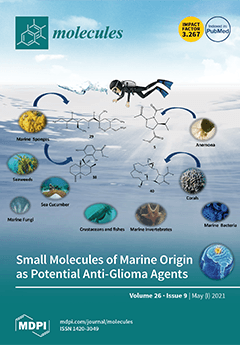Spontaneous emissions of
S. dentata Aiton and
S. scabra Thunb., as well as the essential oil (EO) composition of the cited species, together with
S. aurea L., were investigated. The chemical profile of the first two species is reported here for the first time. Moreover, in vitro tests were performed to evaluate the antifungal activity of these EOs on
Trichophyton mentagrophytes,
Microsporum canis,
Aspergillus flavus,
Aspergillus niger, and
Fusarium solani. Secondly, the EO antibacterial activity against
Escherichia coli, Staphylococcus aureus, and
Staphylococcus pseudointermedius was examined, and their antiviral efficacy against the H1N1 influenza virus was assessed. Leaf volatile organic compounds (VOCs), as well as the EOs obtained from the arial part of
Salvia scabra, were characterized by a high percentage of sesquiterpene hydrocarbons (97.8% and 76.6%, respectively), mostly represented by an equal amount of germacrene D (32.8% and 32.7%, respectively). Both leaf and flower spontaneous emissions of
S. dentata, as well as the EO composition, showed a prevalence of monoterpenes divided into a more or less equal amount of hydrocarbon and oxygenated compounds. Interestingly, its EO had a non-negligible percentage of oxygenated sesquiterpenes (29.5%).
S. aurea EO, on the contrary, was rich in sesquiterpenes, both hydrocarbons and oxygenated compounds (41.5% and 33.5%, respectively).
S. dentata EO showed good efficacy (Minimal Inhibitory Concentration (MIC): 0.5%) against
M. canis. The tested EOs were not active against
E. coli and
S. aureus, whereas a low inhibition of
S. dentata EO was observed on
S. pseudointermedius (MIC = 10%). Once again,
S. dentata EO showed a very good H1N1 inhibition; contrariwise,
S. aurea EO was completely inactive against this virus. The low quantity of
S. scabra EO made it impossible to test its biological activity.
S. dentata EO exhibited interesting new perspectives for medicinal and industrial uses.
Full article






